Outlook
Many of our summer fisheries have started, however, it is still very early. The Chilliwack River is now open. There are still very few chinook in the river and it is running high. The Skagit River also opened July 1st and we should start to hear whisperings of fish very shortly.
Some fish are starting to show on the beaches, but fishing has yet to heat up. Saltwater fishing is in a bit of a transition period. Thrasher has slowed down to a halt, meanwhile some coho have been taken off of West Vancouver.
You know it is summer time when Andre brings in the first batch of his proven coho-catching beach flies!
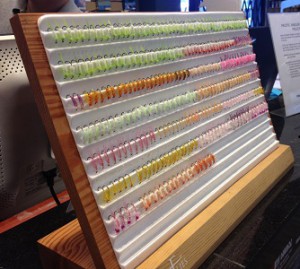 Come on down to the shop and top up your beach box!
Come on down to the shop and top up your beach box!
Upcoming Courses
FLY FISHING ON BEACHES
Class Size: 20
This single evening 3hr seminar will cover the basic principles needed to be an effective beach fly fishermen in BC from Howe Sound to the east coast of Vancouver Island. Topics covered will include rods, reels, fly lines, flies, tides, and techniques. Andre Stepanian, the instructor for this course, has been chasing salmon on our local beaches for over two decades. Remember, east coast Vancouver Island has a pink salmon run every year and last year the Capilano had 12,000 coho!
Book this course early as we sold out all 3courses in 2013!!
Cost: $40.00
Dates : July 23
Time: 6:30pm – 9:30pm
Introductory Article
Skagit River
As of the July 1st the Skagit is open to catch and release fishing. On most years the river is quite high opening day and we recommend waiting until mid July to start fishing. From our latest reports the river is high right now but with varying snow pack levels this year we might have some good fishing earlier than normal. In this report we are going to look at the 3 most effective fly fishing presentations for covering the major food sources in the Skagit river.
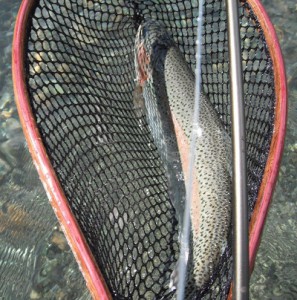
Nice fish caught last year – Thanks Ron!
This first presentation is the simple “Dry Fly” rig. Use a 9ft tapered leader. For most of our trout fisheries we recommend a 5-6lb tapered leader. We then add a 1.5-2ft section of tippet usually one weight class lower than the tapered leader. 5lb is ideal. You will need some dry fly floatant that comes in a past or powder. We apply this to our fly and back portion of the leader. Do not apply the floatant to the last 4 feet of leader because it will float the line and cut a line across the water that turns fish off. Some anglers will use a Sinking pasteto hide the last few feet of leader but it is not a necessity. Flies we recommend for the Skagit include; Parachute Adams in grey and olive in size 10-14. We also like Elk Hair Caddis in the same size and larger Green Drakes later in the season.
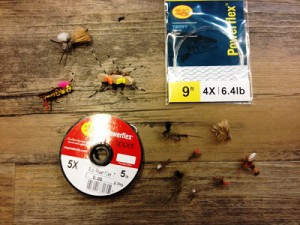 The dry essentials
The dry essentials
The key with this presentation is to achieve a dead drift. Mend and manipulate the line to make sure the fly moves without the line dragging against the current. A couple of tricks we recommend are adding a little twitch to the fly especially in the slower moving pools. If you see a fish that is looking at your fly but not biting give the fly a 2inch twitch pause twitch pause, twitch pause. This will usually get a picky trout to come flying out of the water after your fly. When the fish hits set the hook immediately and then get the slack out of your line.
The second rig is the Indicator Rig. This is used for fishing nymphs that are disturbed from under rocks or are trying to swim to the surface to hatch. We still employ a 9ft tapered leader in the same lb test class as the dry fly. Mono-filament line is great but for this presentation Fluorocarbon line sinks faster and is less visible to the fish. We also add a foot or two of tippet. The knot used to tie on the tippet is important because we are going to use it to anchor a small weight. There are 2 great kinds of weight for this, split shot and putty weight. Put the split shot just above you tippet knot or put the putty around the knot so they do not fall off. The key to this rig is in the indicator. This is used to detect a strike but more importantly it helps us achieve a dead drift. We love the Thing-a-Ma-Bobber indicators for faster water and ease of sight and the fish pimp indicators when maximum casting distance is needed. Cast this rig with a wide loop to keep things from tangling and we recommend a 45 degree up stream cast. Mend the line aggressively. I like to see the indicator move or pop just a little bit with each mend.
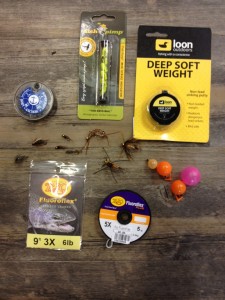
The basic gear for Nymphing
Our favorite flies are Golden Stones and Olive Stones in size 8-10. For Mayfly imitation use the Hairs Ear and Pheasant Tails in 10s-16s.
A couple tricks with this method are to mend aggressively and be constantly analyzing your drift. If you can mend just enough to pop the indicator off the water we can get an idea of what direction your leader is heading below the fly. This helps us analyze the drift and depth. Remember the water at the surface is moving faster than the water below so you might have you indicator dragging the fly down-stream. Popping it up stream 4-8inches will correct this. Oh – And set the hook on anything that looks funny. If the indicator hesitates or dips under, I like to use what is called a set mend. Aggressively try to pop the indicator. If it does not react correctly to the mend (because of a fish or bottom) continue the aggressive lifting motion into a strike. If it pops cleanly off the water drop it back down to continue your drift.
Every January/February we put on the famous Nymphing Course where we take an in-depth look at this presentation and then take you out on the water to prefect the techniques. If interested call the shop to get on the waiting list or keep your eyes open for next year’s course schedule coming in early November.
The last technique that we fish in these areas is the swung fly strip. This is a great method for catching salmon and steelhead but it is also great presentation for big bull trout and dollies as well as the odd rainbow. We use a sink tip for this method and even if you don’t have a sink tip line you can purchase a sinking poly leader that loops onto any standard dry line. Though it doesn’t cast as well as a full sink tip line it works well to get you in the game.
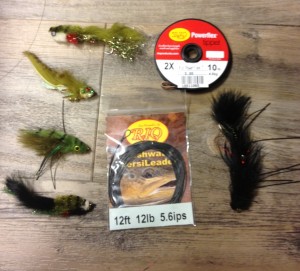
For the Skagit use large olive and black streamers on the Thompson use large salmon fry imitations.
Next time you head out to the trout rivers around the province, make sure you can cover all 3 of these presentations and you will put more fish to the bank. If you have any questions come in to the shop and we will walk you through the gear or give us a call and we can help you over the phone.
Make sure to check the river levels before you head out to your favourite river. For a detailed look into the local river scene please read the river fishing report below:
Freshwater Reports
RIVERS
Squamish
There won’t be much to say about this river system until the fall. Resident trout can be targeted in the summer months once the water has dropped. These trout are best targeted with nymphs, streamers, and dry flies.
Squamish Cheakamus system is a 100% catch and release, single barbless fishery so play by the rules and have fun!
Chilliwack River
The water has cleaned up very nicely for opening week. The river already has 3-5ft of visibility from Tamihi down. Although the clarity is very good, the water is still quite high. Many of the side channels are still not wade-able. There are very few signs of salmon in the river yet but this will soon change. Fish will start to show up in numbers in the next two weeks. Until then, try to focus your efforts on the small pieces of resting water that are available in high water conditions. You might get lucky and find a pod of moving fish!
The summer chinook average 8-15lbs but fish in the 20 and 30lb weight class are caught every season. The run isn’t as large as the White Springs that enter the river in the fall so it is recommended to cover lots of water throughout the day to be successful. Chinooks are brutes and will hold in slightly deeper and heavier water.
Float fishing is the most effective method for these fish. Medium-heavy casting or center pin outfits are suitable for this fishery. Don’t be afraid to go big, 35g floats with hollow core pencil lead, 20lb mainline, 15lb-20lb Seaguar Blue label fluorocarbon leader, and 1/0, 2/0 and 3/0 octopus hooks. This heavy gear will not only help you land the fish but it will allow you to fish the heavier water more effectively. Productive baits are Pro-cured roe, Prawns, Wool combinations, Blades, and Spoons. Water clarity will affect the size of your presentation, typically it will hover around 1ft to 2.5ft of visibility most of July, however, the clarity is already greater than 3ft.
Check the river levels to keep up with the current conditions.
Please familiarize yourself with salmon identification as you may encounter Cultus Lake Sockeye which MUST BE RELEASED WITH CARE.
Check http://www.pac.dfo-mpo.gc.ca/fm-gp/rec/fresh-douce/region2-eng.html for regulations on salmon fishing in Region 2.
Skagit:
Opened July 1st. Catch and release, bait ban.
See article above.
Chehalis River
The Chehalis River is now open to fishing. The river is running quite low and clear at the moment making fishing tough. Chinooks usually shy away from entering the river when it is low. There are some fish in the river at the moment, but you can expect some fresh ones with the next bump of rain water.
Capilano River
Water! We need water! We advise everyone in the Vancouver area to immediately stop showering and washing their cars. On second thought, please continue to regularly bathe. This river really needs some higher flows, not only to bring in fresh fish, but to give the stale fish a chance to move around and relax. This is possibly the lowest and slowest season we have seen in a while. It could still shape up to be a good season if we get some higher flows for more than a few days! The beach is definitely your best bet until we get some rain.
Please note: ALL steelhead(adipose clipped and unclipped) must be released with the utmost care.
The most popular method for this fishery is short-floating with light/medium power casting and center-pin rods. Productive baits include cured roe, roe bags, krill, dew worms, and Colorado blades. Fly fishing is also quite effective for these early run coho. 7-8wt single hand fly rods equipped with full sinking type-6 lines allow you to strip your fly while maintaining a deep presentation. The most effective flies are olive woolly buggers (Andre’s Cap Coho Bugger), muddler minnows, and small polar bear winged flies in sizes 8-12.
Tidal Fraser
Currently until July 16th there is no fishing for salmon. That being said the muddy Tidal Fraser should not be over looked. Coarse fishing for peamouth chub, Northern Pike minnow, and Sculpin is a great alternative to fishing our local trout lakes. Bottom fishing and float fishing with dew worms for these small but plentiful minnow species is a summer time activity which the whole family can partake in. One can also enjoy the world class sturgeon fishery we have either from shore or from a boat. Essentials for this fishery is a lawn chair and heavy gear. Productive baits are roe, dew worms, and finfish. Come by the shop if you have any questions and we’ll be more than happy to answer them.
Sam Graham.
Interior Lakes
The lake temps are rising as we head into to summer doldrums. If you still want to head out choose lakes 4500 ft in elevation and above. You might still encounter a damselfly hatch but the big ticket will be the Caddis hatch if you are lucky enough to hit it. Don’t rule out leeches in the morning and the evening as the fish are more active in the cooler part of the day.
For more in depth information and getting set up for your trip please drop by the store.
Andre & Max.
Local Lakes
Rice lake is still fishing well. It was stocked on Father’s day, so it should continue to fish well into the summer.
We encourage people to take the introductory angler in their life to one of these stocked lakes. It is a great way to get people into the sport based on how willing the fish are and proximity to the city.
The Whistler Lakes are fantastic this time of year. We have heard good reports from Alta lake and Nita lake recently. The species of target in Alta lake are cutthroat trout and rainbow trout. Cutthroat are best targeted with woolly bugger and minnow type flies like muddlers and belly dancers or small spoons like a Dick Nite. The rainbows can be taken on a variety of flies. Chironomids fished under an indicator can actually work quite well on Alta for rainbows.
Beach: (West Van)
I went to the beach last Friday for the first time and saw quite a few fish. They did come into casting range but unfortunately I did not hook up trying some new patterns. If you are going to check it out, make sure to head out 2 hours before low tide and fish through the high tide. Look for fining fish on the surface to maximize your chances. Until the fishing is more consistent (mid July), casting at surfacing fish will increase your chances rather than endlessly blind casting. We now have the beach flies that I have tied for our local area and the island.
Happy fishing and see you out there,
Andre.
Local Saltwater
It looks like Thrasher is pretty much done for the year as this past week has seen some difficult fishing over there as both Eddie, Dimitri and I had some lack luster days there in the back end of June. We are hearing of some good fishing up by Campbell River, and perhaps some fish will be pushing south, but by that time the fishing locally will have picked up enough that we won’t be heading across the Strait.
The coho are starting to trickle in off W. Van and Eddie boxed a nice one on Wed morning after making a pass on his way back from Hole in the Wall up in Howe Sound. This area has been producing a few chinook, but it has been hot one day and cold the next as these chinook cruise up the Sound on their way to the Squamish and Cheakamus rivers.
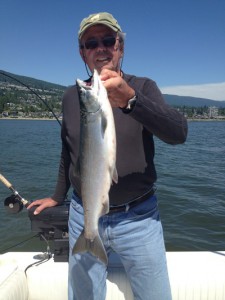
Eddie made a pass along W. Van and picked up this nice hatchery coho. They are starting to show up!
There have also been a few chinook caught off the Bell Buoy and out towards the QA marker, but again, it has been spotty with fish there one day and gone the next. This is typical for the beginning of July, there a few coho around off W. Van, there are few chinook around the Bell Buoy and QA, there are a few chinook around up in Howe Sound, and Thrasher is winding down. The best thing to do is pick your spot and put in the time and with a bit of luck you will be there on the right day and have some pretty good fishing. Things will be picking up over the coming weeks as more coho start to populate the W. Van shoreline and more Fraser River chinook start to show up.
Here are the latest fisheries announcements that you should be aware of regarding coho and chinook retention. Chinook will be open off the “Fraser Mouth” July 16th and there are some limited opportunities for retention of wild coho in Areas 13, 18, 19, 29. You can not keep wild coho off of W. Van. Please read the fisheries notices below and then click on the Area 29 Map so you know where you can and can not keep wild coho. It is exciting to see that the coho stocks are on the rise in general, and that there are now opportunities for retention of wild fish, but the areas are limited, so take the time to learn these areas. It is also nice to see the chinook opening up in a few weeks, and we are looking forward to heading down to T-10 and Sandheads.
To book your trip give Jason a call at 778-788-8582. If you are heading out in your own boat, stop by the shop for the latest up to the day report and info on the hot flashers and spoons.
On behalf of the Pacific Angler staff we wish you the best in your fishing endeavors and we hope to see you either at the shop or on the water. To check out the latest Pacific Angler news view the Pacific Angler Facebook page.
-Jason, Matt, Max, Andre, Sam, and Eddie.



